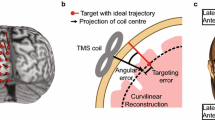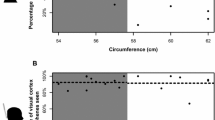Abstract
Transcranial magnetic stimulation (TMS) applied over the occipital lobe approximately 100 ms after the onset of a stimulus decreases its visibility if it appears in the location of the phosphene. Because phosphenes can also be elicited by stimulation of the parietal regions, we asked if the same procedure that is used to reduce visibility of stimuli with occipital TMS will lead to decreased stimulus visibility when TMS is applied to parietal regions. TMS was randomly applied at 0–130 ms after the onset of the stimulus in steps of 10 ms in occipital and parietal regions. Participants responded to the orientation of the line stimulus and rated its visibility. We replicate previous reports of phosphenes from both occipital and parietal TMS. As previously reported, we also observed visual suppression around the classical 100 ms window both in the objective line orientation and subjective visibility responses with occipital TMS. Parietal stimulation, on the other hand, did not consistently reduce stimulus visibility in any time window.



Similar content being viewed by others
References
Abrahamayan A, Clifford CWG, Ruzzoli M, Phillips D, Arabzadeh E et al (2011) Accurate and rapid estimation of phosphene thresholds (REPT). PLoS One 6:e22342
Ahissar M, Nahum M, Nelken I, Hochstein S (2009) Reverse hierarchies and sensory learning. Philos Trans R Soc Lond B Biol Sci 364:285–299
Amassian VE, Cracco RQ, Maccabee PJ, Cracco JB, Rudell A, Eberle L (1989) Suppression of visual perception by magnetic coil stimulation of human occipital cortex. Electroencephalogr Clin Neurophysiol 74:458–462
Barker AT, Freeston IL, Jalinous R, Merton PA, Morton HB (1985) Magnetic stimulation of the human brain. J Physiol (Lond) 369:3P
Bullier J (2001) Integrated model of visual processing. Brain Res Brain Res Rev 36:96–107
Corthout E, Uttl B, Walsh V, Hallett M, Cowey A (1999a) Timing of activity in early visual cortex as revealed by transcranial magnetic stimulation. NeuroReport 10:2631–2634
Corthout E, Uttl B, Ziemann U, Cowey A, Hallett M (1999b) Two periods of processing in the (circum)striate visual cortex as revealed by transcranial magnetic stimulation. Neuropsychologia 37:137–145
Cowey A, Walsh V (2000) Magnetically induced phosphenes in sighter, blind and blindsighted observers. Neuroreport 11:3269–3273
de Graaf TA, Goebel R, Sack AT (2011a) Feedforward and quick recurrent processes in early visual cortex revealed by TMS? Neuroimage 61:651–659
de Graaf TA, Herring J, Sack AT (2011b) A chronometric exploration of high-resolution ‘sensitive TMS masking’ effects on subjective and objective measures of vision. Exp Brain Res 209:19–27
Di Lollo V, Enns JT, Rensink RA (2000) Competition for consciousness among visual events: the psychophysics of reentrant processes. J Exp Psychol Hum Percept Psychol 129:481–507
Fahrenfort JJ, Scholte HS, Lamme VAF (2007) Masking disrupts reentrant processing in human visual cortex. J Cogn Neurosci 9:1488–1497
Felleman D, Van Essen D (1991) Distributed hierarchical processing in the primate cerebral cortex. Cereb Cortex 1:1–47
Fernandez E, Alfaro A, Tormos JM, Climent R, Martinez M, Vilanova H, Walsh V, Pascual-Leone A (2002) Mapping of the human visual cortex using image-guided transcranial magnetic stimulation. Brain Res Brain Res Protoc 10:115–124
Ffytche DH, Howseman A, Edwards R, Sandeman DR, Zeki S (2000) Human area V5 and motion in the ipsilateral visual Weld. Eur J Neurosci 12:3015–3025
Fried PJ, Elkin-Frankston S, Rushmore RJ, Hilgetag CC, Valero-Cabre A (2011) Characterization of visual percepts evoked by noninvasive stimulation of the human posterior parietal cortex. PLoS One 6(11):e27204
Gross CG, Bender DB, Mishkin M (1977) Contributions of the corpus callosum and the anterior commissure to visual activation of inferior temporal neurons. Brain Res 131:227–239
Hallett M (2000) Transcranial magnetic stimulation and the human brain. Nature 406:147–150
Herwig U, Satrapi P, Schonfeldt-Lecuona C (2003) Using the international 10-20 EEG system for positioning of transcranial magnetic stimulation. Brain Topogr 16:95–99
Hochstein S, Ahissar M (2002) View from the top: hierarchies and reverse hierarchies in the visual system. Neuron 36:791–804
Jacobs C, Goebel R, Sack AT (2012) Visual awareness suppression by pre-stimulus brain stimulation: a neural effect. Neuroimage 59:616–624
Kamitani Y, Shimojo S (1999) Manifestation of scotomas created by transcranial magnetic stimulation of human visual cortex. Nat Neurosci 2:767–771
Kammer T (1999) Phosphenes and transient scotomas induced by magnetic stimulation of the occipital lobe: their topographic relationship. Neuropsychologia 37:191–198
Kammer T (2007) Visual masking by transcranial magnetic stimulation in the first 80 milliseconds. Adv Cogn Psychol 3:177–179
Kammer T, Puls K, Erb M, Grodd W (2005a) Transcranial magnetic stimulation in the visual system. II. Characterization of induced phosphenes and scotomas. Exp Brain Res 160:129–140
Kammer T, Puls K, Strasburger H, Hill NJ, Wichmann FA (2005b) Transcranial magnetic stimulation in the visual system. I. The psychophysics of visual suppression. Exp Brain Res 160:118–128
Kastner S, Demmer I, Ziemann U (1998) Transient visual field defects induced by transcranial magnetic stimulation over human occipital pole. Exp Brain Res 118:19–26
Knight R, Mazzi C, Savazzi S (2013) Shining new light on dark perceptions: visual percepts induced by TMS of the occipital cortex. Poster presented at the annual Cognitive Neuroscience Society (CNS) meeting. San Francisco, CA, April 13–16
Koivisto M, Mäntylä T, Silvanto J (2010) The role of early visual cortex (V1/V2) in conscious and unconscious visual perception. Neuroimage 51:828–834
Koivisto M, Railo H, Salminen-Vaparanta N (2011) Transcranial magnetic stimulation of early visual cortex interferes with subjective visual awareness and objective forced-choice performance. Conscious Cogn 20:288–298
Koivisto M, Mäntylä T, Silvanto J (2012) Unconscious response priming by shape depends on geniculostriate visual projection. Eur J Neurosci 35:623–633
Konen CS, Kastner S (2008) Two hierarchically organized neural systems for object information in human visual cortex. Nat Neurosci 11:224–231
Lamme VAF, Roelfsema PR (2000) The distinct modes of vision offered by feedforward and recurrent processing. Trends Neurosci 23:571–579
Lewis JW, Van Essen DC (2000) Mapping of architectonic subdivisions in the macaque monkey, with emphasis on parieto-occipital cortex. J Comp Neurol 428:79–111
Macknik S, Martinez-Conde S (2007) The role of feedback in visual masking and visual processing. Adv Cogn Psychol 3:125–152
Marg E, Rudiak D (1994) Phosphenes induced by magnetic stimulation over the occipital brain: description and probable site of stimulation. Optom Vis Sci 71:301–311
Marzi CA, Antonini A, Di Stefano M, Legg CR (1982) The contribution of the corpus callosum to receptive Welds in the lateral suprasylvian visual areas of the cat. Behav Brain Res 4:155–176
Marzi C, Mancini F, Savazzi S (2009) Interhemispheric transfer of phosphenes generated by occipital versus parietal transcranial magnetic stimulation. Exp Brain Res 192:431–441
Morgan M (1999) Making holes in the visual world. Nat Neurosci 2:685–686
Orban GA, Claeys K, Nelissen K, Smans R, Sunaert S, Todd JT, Wardak C, Durand JB, Vanduffel W (2006) Mapping the parietal cortex of human and non-human primates. Neuropsychologia 44:2647–2667
Panichello M, Cheung O, Bar M (2012) Predictive feedback and conscious visual experience. Front Psychol 3:620
Parks NA, Beck D, Low KA, Maclin EL, Tapia E, Savazzi S, Mazzi C, Fabiani M, Gratton G (2013) Dynamic measurement of functional connectivity using simultaneous fast optical imaging and magnetic stimulation. Talk presented at the annual Society for Psychophysiological Research (SPR) meeting, Florence, Italy, October 2–6
Railo H, Koivisto M (2012) Two means of suppressing visual awareness: a direct comparison of visual masking and transcranial magnetic stimulation. Cortex 48:333–343
Sack AT, van der Mark T, Schuhmann T, Schwarzbach J, Goebel R (2009) Symbolic action priming relies on intact neural transmission along the retino-geniculo-striate pathway. Neuroimage 44:284–293
Silver MA, Kastner S (2009) Topographic maps in human frontal and parietal cortex. Trends Cogn Sci 13:488–495
Silver MA, Ress D, Heeger DJ (2005) Topographic maps of visual spatial attention in human parietal cortex. J Neurophysiol 94:1358–1371
Stokes MG, Chambers CD, Gould IC, English T, McNaught E, McDonald O, Mattingley JB (2007) Distance-adjusted motor threshold for transcranial magnetic stimulation. Clin Neurophysiol 118:1617–1625
Swisher JD, Halko MA, Merabet LB, McMains SA, Somers DC (2007) Visual topography of human intraparietal sulcus. J Neurosci 27:5326–5337
Thielscher A, Reichenbach A, Uğurbil K, Uludağ K (2010) The cortical site of visual suppression by transcranial magnetic stimulation. Cereb Cortex 20:328–338
Webster MJ, Bachevalier J, Ungerleider LG (1994) Connections of inferior temporal areas TEO and TE with parietal and frontal cortex in macaque monkeys. Cereb Cortex 4:470–483
Acknowledgments
We thank Dustin Martin, Martin Prete and Lu Echo Ye for assistance with data collection. This research was conducted while Evelina Tapia was a postdoctoral trainee in the Cognitive Psychophysiology Training Program at the Department of Psychology, University of Illinois at Urbana–Champaign (National Institute of Mental Health National Research Service Award MH19554 to the University of Illinois).
Author information
Authors and Affiliations
Corresponding author
Rights and permissions
About this article
Cite this article
Tapia, E., Mazzi, C., Savazzi, S. et al. Phosphene-guided transcranial magnetic stimulation of occipital but not parietal cortex suppresses stimulus visibility. Exp Brain Res 232, 1989–1997 (2014). https://doi.org/10.1007/s00221-014-3888-y
Received:
Accepted:
Published:
Issue Date:
DOI: https://doi.org/10.1007/s00221-014-3888-y




